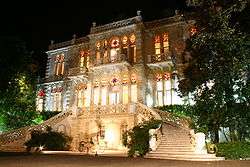Sursock Museum
Coordinates: 33°53′34.59″N 35°30′58.42″E / 33.8929417°N 35.5162278°E

.jpg)
The Sursock Museum, which is officially known as the Nicolas Ibrahim Sursock Museum, is a modern art and contemporary art museum in Beirut, Lebanon.
History
In 1912, the wealthy and prominent Lebanese aristocrat Nicolas Ibrahim Sursock built the private villa that now houses the museum. He decreed in his will that the villa be transformed into a museum.[1] When he died in 1952, he bequeathed the villa to the city of Beirut.[2] The museum opened its doors in 1961, directed by Ibrahim M. Beyhum, with an exhibit of works of contemporary Lebanese artists, setting a precedent for cultural events in Beirut.[3]
The Sursock Museum building exemplifies Lebanese architecture, with its Italianate (specifically Venetian) and Ottoman architectural influences.[2] It is one of the few remaining villas from its epoch in Beirut. It is located in the historic Rue Sursock street in the Achrafieh district of Beirut. The street is home to other mansions that were built in the 19th century by Beirut's most prominent families, such as the Sursocks and the Bustroses, even though this architectural heritage is threatened by developers and an almost-unregulated real estate market.
More than a hundred exhibitions have been held at the museum, including displays of works by Lebanese and international artists. The museum's permanent collection includes modern art, Japanese engravings and Islamic art.[4] The museum collection consists of over 800 artworks, including paintings, sculptures, and graphic arts from the 19th and 20th centuries.[5]
Expansion
The museum was expanded with four new underground floors beneath the current garden, at a cost of 12 million dollars (US).[5] French architect Jean-Michel Wilmotte and Lebanese architect Jacques Abou Khaled designed the expansion project.[6]
The project increased the museum’s area from 1,500 square meters to 8,500 square meters and opened additional exhibition spaces, a research library, an auditorium, a restoration workshop, new storage spaces for the collection, as well as a store and restaurant.[7] The museum reopened its doors on October 8, 2015.
Museum collection
The following is a list of Lebanese and international artists whose works are in the museum’s permanent collection:
|
|
|
|
See also
References
- ↑ Guides.hotelbook.com, Events Guide: Sursock Museum (Sursock Museum, Beirut, Lebanon)
- 1 2 Daratalfunun.org Archived 2007-04-23 at the Wayback Machine.
- ↑ Galleries Beirut, Sursock museum, Georges Guv Aref Rayess, John Haddian, Levon Moumjian. Madi Hussein
- ↑ Lebanon-tourism.gov.lb
- 1 2 Annahar.com Archived 2008-09-26 at the Wayback Machine.
- ↑ Jadesigns-architects.com
- ↑ http://www.dailystar.com.lb/News/Local-News/Jul/14/Mitri-presents-project-to-expand-Sursock-
External links
- Sursock Museum website
- Lebanon.com information
- Onefineart.com information